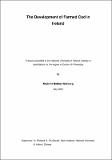| dc.contributor.advisor | FitzGerald, Richard D. | |
| dc.contributor.author | Bolton-Warberg, Majbritt | |
| dc.date.accessioned | 2012-09-14T08:15:15Z | |
| dc.date.available | 2015-11-20T10:33:36Z | |
| dc.date.issued | 2012-05-25 | |
| dc.identifier.uri | http://hdl.handle.net/10379/2968 | |
| dc.description.abstract | This study is interlinked with the work programme of the EIROCD project. Utilising historical data and empirical experimental approaches, various aspects of development, growth and phenotypic plasticity of North Atlantic cod, particularly the Celtic Sea stock, were examined.
An examination of the wild stocks around Ireland revealed differences in population dynamics. The Celtic Sea stock had the highest growth rate of all Irish stocks considered, which prompted its' use as the base population for the development of the national broodstock and breeding programme (EIRCOD). The growth performance of farmed Irish cod was confirmed and benchmarked. Although there was a clear need for the improvement of our larval rearing strategy, growth was remarkably consistent across all year classes. Previously established growth models for more northerly populations were found to be useful within certain constraints for predicting growth of cod under Irish conditions. Comparative modelling of growth in different countries revealed a competitive advantage to Irish cod farmed during the first and second years. The effects of temperature on egg development as well as larval and juvenile growth were examined. Optimum temperatures for growth of Celtic Sea juveniles have been established and are remarkably similar to those estimated for more northerly stocks; however, actual growth rates were lower than those predicted from models. Body shape variation in the head and shoulder region was examined and has the potential to easily discriminate between wild and farmed cod populations. Phenotypic plasticity in body shape was also explored and results suggest that cod are capable of adaptive change in morphological features in response to changing environmental conditions. Finally, it has been demonstrated that the performance of farmed cod in Ireland, prior to selective breeding, is as good as that found in the wild Celtic Sea stock. | en_US |
| dc.rights | Attribution-NonCommercial-NoDerivs 3.0 Ireland | |
| dc.rights.uri | https://creativecommons.org/licenses/by-nc-nd/3.0/ie/ | |
| dc.subject | Farmed cod | en_US |
| dc.subject | Ireland | en_US |
| dc.subject | Aquaculture | en_US |
| dc.title | The Development of Farmed Cod in Ireland | en_US |
| dc.type | Thesis | en_US |
| dc.local.note | Using historical data and experimental approaches, various aspects of the development, growth and body shape of North Atlantic cod, particularly the Celtic Sea stock, were examined. | en_US |
| dc.local.final | Yes | en_US |
| nui.item.downloads | 5 | |


